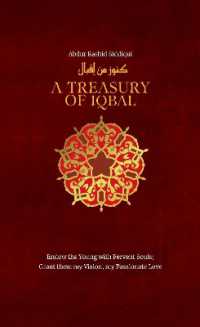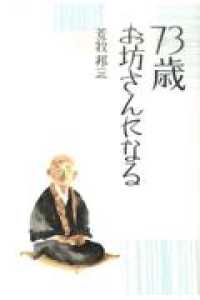Full Description
How do young children learn math and science? Exploring Science and Mathematics in a Child's World examines the development of learning theory through twelve concept explorations on basic natural science themes. The book models how best learning practices are constructed in classroom settings. It also demonstrates how to apply mathematical concepts in authentic minds-on and hands-on experiences related to science. Part One lays the foundation of child development, interrelated mathematics and science processes, and Concept Exploration design. Concept Exploration provides an alternative approach to the usual reliance on a basis model, enabling the teacher and students to explore a wider range of design concepts. This is outlined in Chapter Six. Part Two contains chapters of activities based around a theme such as water, clouds, sun and shadows, wind, birds, insects, and more. All of the activities correlate to the NSES and NCTM standards. This is pictured in a chart at the beginning of each activity chapter for easy reference. For schools where blended math and science courses are offered, this book fills a need as one that demonstrates appropriate content integration and will be a great reference for teachers for many years.
Contents
PART IChapter 1: A CHILD'S WORLD - How Young Children LearnINTRODUCTIONImplications for Adults A Child's World of Cause and EffectCreating Environments that Support DevelopmentHow Emergence of Language Supports Mathematics and Science LearningEmergence of Symbolic LanguageMathematics DevelopmentPattern - the underlying theme of all mathematic and scienceSequence - organization and order of succession of events and experiencesSeriation - organizing or ordering things in a logical waySpatial RelationshipsObject PermanenceSorting - putting together items with like attributesComparing - noting similarities and differences between items or events ClassifyingOne-to-One CorrespondenceThinking SkillsObservingImaginingProblem Solving Collecting and Organizing DataNational Standards in Mathematics and ScienceReview and Discussion QuestionsCHAPTER 2: NURTURING CHILD DEVELOPMENT - Environments that Promote LearningINTRODUCTIONCreating a Culture of Caring: The Teacher's RoleValuing Children and ChildhoodSafety within a Caring CulturePlayProviding Emotional SecurityBeing ResponsiveConstructing Meaning through MisconceptionsBuilding a Sense of CommunityFamilies and Schools TogetherChildren's Questions and CuriositiesExperiencing NewnessEncouraging Wonder and DiscoveryTeachers' Roles in Creating a Curious ClassroomWiggle Room and Opportunities for MovementCreating an Environment Cooperative Culture for Independent Thinking Concept Explorations - Long term projectsDocumenting Experiences Documenting through Concept ExplorationReview and Discussion QuestionsINTRODUCTIONThe Nature of Problem SolvingProblem-Solving StylesActive Versus Reflective StylesHow Problem-Solving Styles Affect Classroom Practices and Student Experiences Teacher TendenciesStudent TendenciesTeacher and Student InteractionsRandom Abstract Teachers and Concrete Sequential StudentsConcrete Sequential Teachers and Random Abstract StudentsClassroom Experiences with Problem SolvingAuthentic Learning - Problem Solving in the Real WorldDesign of Classroom Activities that Encourage Problem SolvingTeaching at Each of the Four Stages of Problem SolvingCollecting and Organizing DataReview and Discussion Questions SCIENCEINTRODUCTIONUsing Senses to Experience the WorldHow Things Change and GrowSeeking Inventive Ways to Capture Change and GrowthFormal Approaches and Techniques of MeasurementNational Standards Concerning MeasurementInstructional Psychology for Teaching MeasurementSome Ideas for Teaching Children to MeasureWays to Help Children Communicate and Share Mathematical IdeasGroup Sharing and Discussion FormatJournaling Making a Book Modeling Appropriate Mathematical and Scientific LanguageRelating Rational Counting of Units to the Process of MeasurementProviding Discrete Items to Count when MeasuringDeveloping Referents for MeasurementTemperatureReview and Discussion QuestionsResources for Teachers INTRODUCTIONUsefulness of Charts and GraphsTypes of ChartsWebsVenn DiagramsTypes of GraphsPeople GraphsConcrete GraphsPictographsBar GraphsHistogramsCircle GraphsLine GraphsUsing Maps to Organize DataReview and Discussion QuestionsResources for TeachersCHAPTER 6: CRITERIA FOR DEVELOPING CONCEPT EXPLORATIONSINTRODUCTIONProvides Solid Science and Mathematics ContentSolid Science ContentSolid Mathematics ContentConsiders the Appropriate Level of Child DevelopmentTruly Integrates Mathematics and ScienceIs Guided by the Child's WorldIncorporates Children's LiteratureActively Involves Children through Common Basic MaterialsIs Founded on a Safe EnvironmentConcept Exploration DesignConcept Exploration IntroductionConcept Exploration Activities for your Classroom Conceptual Framework for Science and Mathematics Children's ExplorationsNational Science Education StandardsNational Council of Teachers of Mathematics National StandardsThe Pre-K - 2 Content StandardsThe Pre-K - 2 Process StandardsResourcesResource BooksStorybooksPicture BooksMulticultural BooksWriting Your Own BookReview and Discussion QuestionsPART II MATH/SCIENCE CONCEPT EXPLORATIONSCHAPTER 7: ASTRONOMY AND SPACE SCIENCEINTRODUCTIONSCIENCE CONCEPTS FOR TEACHERSNewton's Three Laws of Motion and Basic RocketryStar FormationTelescopes and ChildrenMathematics: Addressing the NCTM Standards through Concept ExplorationsNumber and OperationAlgebra and PatternsGeometryMeasurementData AnalysisObserving with All the SensesSightSoundSafetyConcept Explorations on Astronomy and Space Science for Your Classroom1. Solar System Models2. Solar Dances3. Golf Ball Lunology4. Moon Watching5. Binocular Beauties6. Observing the Sun7. Collecting Micro-Meteorites8. Balloon Rockets9. Film Canister Rockets10. Water Rockets11. Air Rockets12. Chemical Rockets13. How High Did It Go?Activities in Other Exploration That Relate to Astronomy and Space ScienceResources for TeachersBooksArticleWebsitesChildren's Books on Astronomy and Space ScienceCHAPTER 8: BIRDSINTRODUCTIONScience Concepts for TeachersBird Basics Feather Structure and TypesMigratory PatternsMATHEMATICS: ADDRESSING THE NCTM STANDARDS THROUGH CONCEPT EXPLORATIONSNumber OperationAlgebra and Patterns GeometryMeasurementData Analysis with Number and OperationObserving with All the SensesSightTouchSoundSAFETY1. Adopt a Bird2. Feed the Birds3. Chart the Birds4. Food Preferences of Birds5. Constructing Bird Hotels6. What's A Bird Have to Say?7. Construction Time: Can You Build as Well as a Bird?8. Fright Distance9. How Do Birds Interact with Each Other and with Other Animals10. How High Do Birds Fly?11. Where Do Birds Go for the Winter?12. Feathers of Fine Friends13. Egg Incubators14. How Much Does a Bird Weigh?15. Birds in Different CulturesActivities in Other Explorations that Relate to BirdsResources for TeachersBooksJournal Computer DiskWeb SitesChildren's Books on BirdsCHAPTER 9: CLOUDSINTRODUCTIONSCIENCE CONCEPTS FOR TEACHERSWhat Causes CloudsTypes of CloudsMathematics: Addressing the NCTM Standards Through Learning ExperiencesAlgebraGeometryMeasurementData Analysis OBSERVING WITH ALL THE SENSESSightSoundSAFETY1. Head in the Clouds2. Capture the Clouds3. Catch Your Breath4. How High Is a Cloud?5. What to Do with the Weather6. Cloudy Sky Stories7. I've Looked at Clouds from Both Sides Now8. Which Way are You Going?9. As the Saying GoesActivities in Other Explorations that Relate to CloudsResources for TeachersBooksWebsitesChildren's Books on CloudsCHAPTER 10: INSECTSINTRODUCTIONSCIENCE CONCEPTS FOR TEACHERSInsect BasicsMetamorphosisMATHEMATICS: ADDRESSING THE NCTM STANDARDS THROUGH LEARNING EXPERIENCESNumber and OperationAlgebra, Patterns, and SortingGeometryMeasurementData AnalysisOBSERVING WITH ALL THE SENSESSightSoundTouchSmell and TasteSAFETY1. Let's Build an Insect Zoo2. Create an Insect and Design Its Habitat.3. Bedtime Bonanza4. Plant Hotels5. My Life Story by Billy Beetle6. Insect Galls7. Butterfly Detectives8. Interviewing Insects9. Ant Investigations10. Insect Picnic11. Air Explorations12. Insect Songs13. Underground Activities14. Chromo PubescentsActivities in Other Explorations that Relate to InsectsResources for TeachersBooksArticlesWeb SitesChildren's Books on InsectsCHAPTER 11: LEAVESINTRODUCTIONSCIENCE CONCEPTS FOR TEACHERSThe Value of LeavesPhotosynthesisCompostMATHEMATICS: ADDRESSING THE NCTM STANDARDS THROUGH CONCEPT EXPLORATIONSNumber and Operation and AlgebraGeometryMeasurementData AnalysisPatterns and SequencingOBSERVING WITH ALL THE SENSESSightSoundTouchSmell SAFETY1. Falling Leaves2. Quiet Leaves3. Leafy Lunch4. Scratch and Sniff5. Evergreens Also Have Leaves6. Insects Like Leaves Too!7. A Tribute to Transpiration8. Leaves - Where Do They All Go?9. Leaves - Alike But Different10. A Rainbow Connection of Leaves11. Leaves' Lasting Impressions12. From a Leaf's PerspectiveActivities in Other Exploration that Relate to LeavesResources for TeachersBooksWeb SitesChildren's Books on LeavesCHAPTER 12: MATH/SCIENCE CONCEPT EXPLORATION: LIGHT AND COLORINTRODUCTIONSCIENCE CONCEPTS FOR TEACHERSWhat Is Light and How Is It Produced?PolarizationLight's Enigma: The Duality of Wave and Particle Theories of LightVisible LightThe Speed of LightThe Normal Sighted EyePrimary ColorsAbsorption and Reflection of LightRefractionWhat Are Lasers and How Do They Work?MATHEMATICS: ADDRESSING THE NCTM STANDARDS THROUGH LEARNING EXPERIENCESNumber and OperationAlgebraGeometryMeasurement Data AnalysisOBSERVING WITH ALL THE SENSESSightSoundSAFETY1. Pinhole Projects2. Mirrors3. Seeing Yourself as Others See You4. The Candle Burning Under Water5. Up Periscope6. Doubling Your Fish7. Reflections of a Laser Pointer8. Magic Marker Magic9. Combining Colors10. Color Television Basic Color11. Paper Chromatography12. Technicolor World13. Grow Plants with a Green Filter14. Visualizing Sound with LightActivities in Other Explorations that Relate to Light and ColorResources for TeachersBooksWeb SitesChildren's Books CHAPTER 13: ROCKSINTRODUCTIONSCIENCE CONCEPTS FOR TEACHERSDon't Take All Rocks for Granite- What are Minerals and Rocks?The Rock CycleMATHEMATICS: ADDRESSING THE NCTM STANDARDS THROUGH CONCEPT EXPLORATIONSNumber and OperationAlgebraGeometryMeasurementData AnalysisOBSERVING WITH ALL THE SENSESSightTouchSoundSAFETY1. Rocks Waiting to Be Found2. Swap Rocks with Students in Other Schools3. My Life Story by Rocky4. Building Stones5. Rainbow Rocks6. Stream Sorting7. Statues, Jewels, and Trinkets8. Rocks - Pieces and Parts9. Fossils10. Graveyard GeologyActivities in Other Explorations That Relate to RocksResources for TeachersBooksWeb SitesChildren's Books on RocksCHAPTER 14: SEEDSINTRODUCTIONSCIENCE CONCEPTS FOR TEACHERSThe Nature of SeedsParts of a SeedSeed GerminationSeed TransportationMATHEMATICS: ADDRESSING THE NCTM STANDARDS THROUGH CONCEPT EXPLORATIONSNumber and OperationAlgebra and PatternsGeometryMeasurementData AnalysisOBSERVING WITH ALL THE SENSESSightTouchSoundTasteSmellSAFETY1. Eating Seeds is Fun!2. What Foods Do We Eat?3. What Do Our Animal Neighbors Eat?4. Seeds Growing in Nature5. The Germination Race6. Trees Grow from Seeds7. Flower Seeds to Flower Seeds8. Pop corn, Indian Corn, Sweet Corn9. Let's be Gentle!10. All Quiet on the Stage!11. Lights, Camera, Action12. Story Time13. Seed MosaicsActivities in Other Exploration that Relate to SeedsResources for TeachersBooks ArticleWeb SitesChildren's Books on SeedsCHAPTER 15: SUN AND SHADOWSINTRODUCTIONSCIENCE CONCEPTS FOR TEACHERSThe Sun is a Nuclear FurnaceThe Earth's Revolution and Rotation Determine the Earth's SeasonsThe Sun in Our SkyObserving the Daily and Annual Motion of the Sun in Our SkyMATHEMATICS: ADDRESSING THE NCTM STANDARDS THROUGH CONCEPT EXPLORATIONSNumber and OperationAlgebraGeometryMeasurementData AnalysisOBSERVING WITH ALL THE SENSESSightTouchSAFETY1. Here Comes the Sun2. I Saw the Sun Move3. Me and My Shadow4. Silhouettes5. Exploring the Shapes and Sizes of Shadows6. Photo Opportunities7. Shadow Game8. The Warmth of the Sun9. The Sun Is a Spotlight10. Mythology and the SunActivities in Other Exploration that Relate to Sun and ShadowsResources for TeachersBooksArticleWeb SitesChildren's Books on Sun and ShadowsCHAPTER 16: TOYS AND TOOLSINTRODUCTIONSCIENCE CONCEPTS FOR TEACHERSSimple MachinesMechanical AdvantageInertiaCenter of GravityFrictionMass and WeightMATHEMATICS: ADDRESSING THE NCTM STANDARDS THROUGH CONCEPT EXPLORATIONSNumber and OperationAlgebraGeometryMeasurementData Analysis and ProbabilityOBSERVING WITH ALL THE SENSESSightTouchSoundSAFETY1. Toy Festival2. How Many Simple Machines Can You Find?3. Rulers and Pencils4. Strings and Things5. The Toy Factory6. Toys of Different Countries7. The Human Machine8. Invention Convention9. The Ball OlympicsActivities in Other Exploration that Relate to Toys and ToolsResources for TeachersBooksArticleWeb SitesChildren's Books on Toys and ToolsCHAPTER 17: WATERINTRODUCTIONSCIENCE CONCEPTS FOR TEACHERSWater CycleA Detailed Water CycleThe Water PlanetThe Curious Nature of WaterMATHEMATICS: ADDRESSING THE NCTM STANDARDS THROUGH CONCEPT EXPLORATIONSNumber and OperationAlgebra, Patterns, and SortingGeometryMeasurementData AnalysisOBSERVING WITH ALL THE SENSESSightTouchSoundTaste and SmellSAFETY1. Splish, Splash2. Water, Water, Everywhere!3. How Much Water Do We Use in a day?4. Don't Drown Lincoln5. Little Water - Big Water6. Water Resources and Water Treatment Plants7. The Classroom River8. Drip, Drop, Tick, Tock9. Water Words10. Water's Work11. Sequencing Water Processes12. I Scream! You Scream! We all Scream for Ice Cream!Activities in Other Exploration that Relate to WaterResources for TeachersBooksJournalWeb SitesChildren's Books on WaterBooks About RainBooks About SnowCHAPTER 18: WIND INTRODUCTIONSCIENCE CONCEPTS FOR TEACHERSWhat Is Wind?Wind ChillMATHEMATICS: ADDRESSING THE NCTM STANDARDS THROUGH CONCEPT EXPLORATIONSGeometryMeasurementData Analysis OBSERVING WITH ALL THE SENSESSightSound TouchSmell and TasteSAFETY1. See the Wind2. Capture the Wind3. Let's Go Fly a Kite4. Construct a Maximum Wind Gust Measuring Device5. Watching the Leaves Blow6. Animals Using the Wind7. Using the Wind to Do Work8. Water Evaporation9. Micro and MacroActivities in Other Explorations That Relate to WindResources for TeachersBooksWebsites Children's Books on WindAPPENDIX: NCTM PROCESS STANDARDS THROUGH GRADE 12REFERENCES








